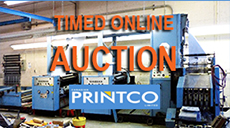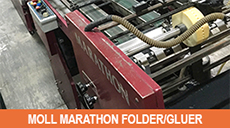Drive pass any factory or office complex in the process of a major clean-up or closure. What do you see? Stockpiles of computers, printers, and photocopiers. Since the launch of the desk-top computer, scenes like this are commonplace. When it comes to photocopiers, the constant redundancy of old machines still prevails. The growing development and penetration of digital printers for commercial use will encounter the same obsolescence cycles as copiers and desk-top printers.
Speed is a major factor in the development of digital offerings. Today’s equipment is for the most part restrained by "sheets per hour" as compared to litho. As time goes on, accellaretion will most certainly increase and this alone, without regard for other enhancements, will force replacement.
Will there be a secondary market for this sort of digital equipment? This question will be at the forefront of not only the user but also the dealer and financier as they will have to reconsider how valuation and in turn real value will be factored. In the world of commercial print there has been a strong understanding of the net worth of a piece of machinery. It could be argued that we as an industry thought of our equipment in the same terms as other industrial segments with projected life cycles understood. The initial new price was substantial but the machine could have some kind of second life in someone else’s plant years from now.
Strong secondary markets have always been essential. However, new digital machinery is gravitating from cast iron to tubular steel, from complicated and expensive machining to a lot more molded plastic. Digital also requires very special imaging and software. Does this create a dilemma in the reselling machines? I believe it does. Just as the photocopier business has created a built in expiry date so does the larger versions appear to head in the same direction. Sub-assemblies with hundreds of parts, pre-manufactured in a way that makes it almost impossible to service, is just one example.
With lithographic technology, machine design is built upon similar concepts 20 or 30 years ago. Once these presses are replaced, they can be relocated and re-installed because the technology is mature and technicians can easily adapt themselves to repair them. But digital is completely different. Not only are they (in most cases) constructed cheaper, they also have the ability to lock out most of the industry from servicing them. The imaging portion be it toner, liquid toner, nano or piezoelectric, is identical to and in most cases owned by the same companies that sell office equipment. These companies control the technology to say nothing of the consumables.
The valuation conundrum is about how we value this new technology. Many (digital machines) are already in the field, and now after Drupa 2012, even more will soon be. This is not just about a new way of printing something. It’s now about how we pay for that machine. Appraisals of value will change.
Charles Fishman’s book, The Wal-Mart Effect, discussed the concept of volume and low prices to sell products. Printer’s who have been able to remain profitable know the need to increase revenue and reduce costs at the same time invest in newer technology. These same companies are paying close attention to the prevailing winds of digital transformation. They also will argue that an extremely expensive piece of machinery has to be financed. The problem is how can the traditional methods of depreciation apply to an expensive machine that is pretty much obsolete in five or less years?
When Heidelberg came out with the GTO-52-DI back in 1991, it was a breakthrough. Just as quickly, buyers realized that, while the concept (of imaging onto a plate) was exciting, the reality was rather poor print quality. Most of those GTO’s quickly retreated to the world of litho with dampeners installed. Although quality wasn’t the issue the 1995, introduction of the Heidelberg QM-46-DI met a similar fate. Other manufacturers brought out similar machines but now they can be purchased for pennies on the dollar. A strong secondary market using dealers to purchase and sell these machines has just about dried up. There are just very few takers. Innovators of direct imaging such as Presstek would certainly disagree as they continue building machines with much higher quality.
Very similar situations exist in the monochrome and color toner markets. As an example, I know of several Kodak Nexpress units that are only +/- 4 years of age and can be had for under $20,000. That is a far cry from what they sold for new. The cut-off point seems to be within the classic a five-year lifespan. This year’s Drupa exhibitors took great pains to talk about “upgradeability” and its assumed manufacturers realize the financial markets (as well as the customer) need assurances of continued viability beyond a few short years. This will be difficult to prove considering the rampant developments in speeds and design of print engines.
For an appraiser, such as myself, the valuation approach requires much more thought and a wider perspective. Many an auctioneer or uninformed machine dealer has stumbled in pricing asset values. Getting three comps does not always do justice to a real value amount.
Today, more than ever, the focus on machinery values needs consideration for the whole operation of the user. Sometimes referred to as Income Approach, a machine’s intrinsic currency assessment is closely tied to the successful utilization and revenue derivative [of digital output devices]. Making a change of this magnitude requires those financing machinery to go beyond the standard risk write-up and this poses additional problems since the world-wide banking crisis of 2007/8. Some would say we could not arrive at this technological shift at a worst time for the printing industry.
The Printing Industries of America (PIA) researched that print shipments reached $147.5 billion dollars by the end of 2011. Over 31,500 plants employing 860,000 people represent a very substantial manufacturing industry. One surmises that print still represents a very large part of the North American economy, and all those producers will need continuous access to funding for new hardware. These statistics show that although the numbers of establishments are down from 10 years ago, there is a substantial base and enough revenue for banks to continue and even strengthen their involvement.
Printers are changing their way of doing business. The mixes of devices successful ones use are much different than even five years ago. This collection embodies both digital as well as enhanced mail and distribution equipment. Perhaps, some have noticed the increased name-changing that has taken hold? Businesses that are named “Acme Printing Co” are keen to alert their customers they are much more than just a printer. Perhaps, it’s changed to “Acme Communications”? Marketing and promotion, as well as new ways to distribute a message, are at the forefront. Hardware is becoming much more secondary to a printer’s patina.
Just as the financial community disregards Fair Market Valuations as being irrelevant, so do the end users see their [business] value as that of a multifaceted delivery system and not a collection of machines. Their worth is in their people and ideas. It still remains however that more and more printers recognize they still need and must continually replace outdated equipment in order to deliver competitively. The difference is the way printers look at their hardware. No longer do they fall in love with equipment as they used to. The trend is much more in lock-step with the banks. Return on investment trumps all.
Digital machines are not going to hold up value-wise like their cousins in the litho world did in the past. But, they [digital] represent the savior of sorts for ink on paper. That’s the valuation conundrum.
|








